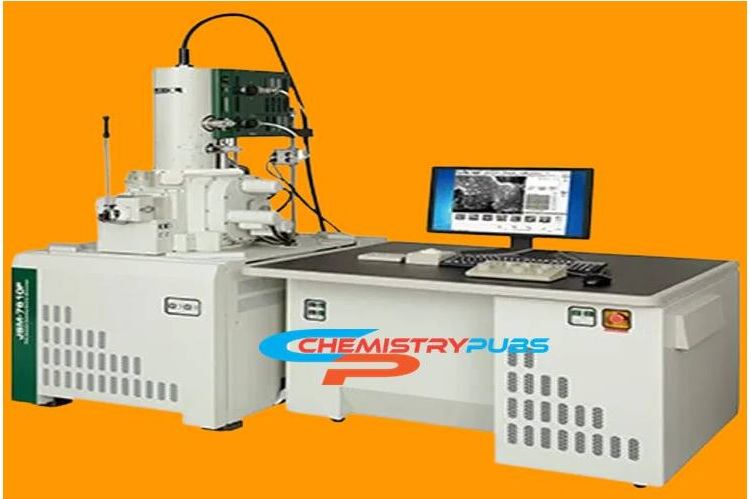SEM or Scanning Electron Microscope uses electrons instead of light to generate high-definition magnified two-dimensional images of the sample. The SEM was first invented by a German researcher and applied physicist and inventor Manfred von Ardenne in 1937. The development of SEM was started in the early 1950s, scanning electron microscopes have developed very much to study in the medical and physical science communities.
The beam of electrons is applied on a selected portion of the surface of the solid sample. Then the interaction occurs between the electrons of the beam and the sample to produce the various output signals. These signals can be recorded and processed further to produce images in a digital format.
The internal structure, the external texture of the specimen, the chemical composition of substances, and the orientation and arrangement of the elements can be known after Scanning Electron Microscope analysis. It creates various opportunities for researchers to examine a much bigger variety of specimens.
This microscope has various outstanding advantages over traditional microscopes. It has the ability to be focused at one time for testing various substances and creates a large depth of research field. The resolution power of SEM is at higher levels. The researcher can control the electromagnets of SEM rather than lenses for getting a proper range of degree of magnification. For creating clear images, make the SEM one of the most useful instruments in research today. The magnification range of SEM is from 20X to approximately 30,000X and the range of spatial resolution is from 50 to 100 nm.

Principle of Scanning Electron Microscope (SEM)
The SEM uses emitted electrons rather than transmitted electrons. This microscope works on the principle of applying kinetic energy to produce signals on the interaction of the electrons. These electrons are generally backscattered electrons, secondary electrons, and diffracted backscattered electrons which are used to view crystallized elements and photons. The secondary electrons and backscattered electrons are used for the production of an image. Occurred secondary electrons emission from the specimen which helps to detect the morphology and topography of the specimen and the backscattered electrons show contrast in the composition of the elements of the specimen.
How does the Scanning Electron Microscope work?
The tungsten filament lamps in Scanning Electron Microscope produce electrons and the electromagnetic lenses which are placed at the top of the column. The electrons are emitted after applying thermal energy to the source of the electron and are allowed to move in a fast motion to the anode, which has a positive charge. The electron beam produces primary scattered electrons at high energy levels and secondary electrons at low-energy levels from the sample surface. The electron beam interacts with the sample to produce signals that give information about the surface topography and composition of the tested sample. It does not require any special treatment for visualization under the SEM, even air-dried samples can be examined directly.
It needs fixation, dehydration, and drying for microbial specimens for maintaining the structural features of the cells and to prevent collapsing of the cells at the time to expose the high vacuum of the microscope. Then samples are properly mounted and coated with a thin layer of heavy metal elements to allow spatial scattering of electric charges on the sample surface and allow better image production, with high clarity. It is possible to scan by this microscope by tapering a beam of electrons back and forth over a thin section of the microscope.
The surface of the specimen releases a small amount of electrons known as secondary electrons after reaching these electrons on the specimen which are then trapped by a special detector apparatus. The detectors detect the secondary electrons after reaching into the detector. It produces flashes of light and gets converted into an electric current by a photomultiplier, sending a signal to the cathode ray tube which produces a clear image that looks like a television picture that can be viewed and photographed.
The quantity of secondary electrons is highly defined by the nature of the specimen which enters into the detector. We can see that the raised surfaces appear brighter on the screen but the depressed surfaces appear darker at the time of analysis.
SEM Uses
Scanning Electron Microscope is a very important analytical tool for analyzing various samples in different fields including biology, pharmaceuticals, manufacturing industries, physics laboratories, and many more. It is widely used in energy-Dispersive X-ray Spectroscopy for spot chemical analysis. It requires biology laboratories to know the internal structures of microorganisms at the cellular level.
It can be used to know the surfaces of solid objects and analyze the distribution of atoms in various elements. Cosmetologists use this microscope to analyze fine details of tiny cosmetic components. Manufacturing industries use this microscope for analyzing the contaminants and impurities in manufactured items. It is used by quality control departments of various industries for determining the purity of a particular substance.
It is also used in qualitative chemical analysis of elements by proving a clear and magnified image of the crystalline structures. This microscope provides precise measurements and detailed images of objects that are over 50nm in size. This microscopic system is used to distinguish different phases of a multiphase sample.
These microscopic parts are equipped with diffracted backscattered electron detectors which helps to examine and determine the microfabric and crystallographic orientation of different type of substances. It is very much used for the production of high-definition images of objects that can display spatial variations of chemical compounds. It is also used to observe bacterial interaction with the skin and body organs.
Advantages and Disadvantages of using the Scanning Electron Microscope (SEM)
A scanning electron microscope has various attractive advantages over other microscopes. This microscope can be used easily and generate results in digital format. It requires a small amount of samples for testing purposes. The resolution power of scanning electron microscopes is higher than other microscopes.
There exist some limitations and disadvantages of a scanning electron microscope. SEM has a bulky structure and requires a lot amount of installation costs. It needs dust free environment and electromagnetic radiation during analysis.
A constant higher voltage level must be maintained for the proper operation of a scanning electron microscope. It requires an attached cooling system for running its proper activities. A smaller amount of solid sample needs to fit within the chamber of the microscope. Light materials such as hydrogen, helium, lithium, etc. should not be used for testing by this SEM.
References
1.Akhtar, K., Khan, S. A., Khan, S. B., & Asiri, A. M. (2018). Scanning electron microscopy: Principle and applications in nanomaterials characterization. Handbook of materials characterization, 113-145.
2.Nixon, W. C. (1971). The general principles of scanning electron microscopy. Philosophical Transactions of the Royal Society of London. B, Biological Sciences, 261(837), 45-50.

